Bain’s annual report on global retail banking customer loyalty is generally one of the most readable of reports of its type. This years’ report contains some surprising and controversial findings. Douglas Blakey reports
Banks that are closing branches in order to cut costs may be scoring an own goal with as many as 40% of customers experiencing a branch closure taking their business to rival banks.
So says Bain’s 2016 Customer Loyalty in Retail Banking global report. At first glance such a finding seems improbably high.
The survey reports major regional variations. Of survey respondents who experienced a nearby branch closure in the past year, 27% in the Netherlands and 54% in India said they completely switched banks or started using some products from a competitor
Moreover, a branch closure caused Net Promoter Scores to drop by an average of 12 percentage points, and as much as 21 points in France, compared with the scores of respondents who did not experience a closure.
Bain argues that the Dutch experience is instructive for many countries. Dutch banks have not completely eliminated brick and mortar, but rather changed the nature of the branch. ING has side counters in bookstores and tobacco shops, while SNS has franchise arrangements with insurance agents and others.
How well do you really know your competitors?
Access the most comprehensive Company Profiles on the market, powered by GlobalData. Save hours of research. Gain competitive edge.

Thank you!
Your download email will arrive shortly
Not ready to buy yet? Download a free sample
We are confident about the unique quality of our Company Profiles. However, we want you to make the most beneficial decision for your business, so we offer a free sample that you can download by submitting the below form
By GlobalDataMost customers in this densely populated country thus still have access to a banker in walking or biking distance, but in a streamlined, low-cost format. So while many Dutch respondents said they have experienced a branch closure, relatively few switched banks or gave a lower Net Promoter Score as a result.
Given that many consumers still use a branch—60% of UK respondents visited one during the previous quarter—the report contends that it would be dangerous to make large cuts to the physical network until customers’ ?nd it easy to handle routine transactions through self-service digital channels.
Banks can accelerate customers’ transition to digital channels, and planning for a new branch network should occur now, as it can take three to ?ve years to recon?gure the network.
Many consumers—about 29% globally on average said Bain—said they would switch their primary bank if it were easy to do so. Again, this is surprising as account switching has never been easier in the UK with the advent of seven-day switching – yet actual switching rates remain stubbornly low.
Younger customers globally were even more likely to express a desire to switch. India, Malaysia and the UK had the largest switching gap between young and old consumers.
Bain estimates that the largest 25 US banks would save more than $11bn annually if these banks reached the level of mobile and online banking use of their counterparts in the Netherlands. They would improve their Net Promoter Score—a key metric of customer loyalty—by an average of 12 percentage points. That’s because mobile interactions are far more likely to delight customers than interactions at branches or through contact centres.
The US has 32 branches per every 100,000 adults, far more than countries such as Germany and The Netherlands but more needs to be done to educate customers in using digital banking before further branch closures.
One of the most controversial findings in the survey is the claim that growth of mobile banking has moderated, increasing by just three percentage points in 2016 to 55%.
Mobile adoption has been highest among the youngest consumers, but there is still ample room for growth among those in their 50s and older. Yet banks still have a major opportunity to encourage older customers to adopt mobile, as seniors’ mobile use is well below that of young customers in every country.
Mobile banking now exceeds online banking among consumers in most countries, with Sweden, South Korea, the Netherlands and Australia leading the way.
A small group of heavy users drives much of the branch and phone activity in every country. Brazil and Mexico have the highest share of heavy users.
Besides the Netherlands, banks in a few other countries have made the greatest progress toward digital self-service by customers: Sweden, Poland and Australia. By contrast, Mexico, China, Hong Kong and India are the most branch-dependent markets
Direct banks and ?ntechs are taking a substantial share of new purchases on the strength of their relatively simple product lines and streamlined user experience, and appear to be well-positioned to continue expanding their share.
Direct banks and ?ntechs share of product purchases reached 34% in the UK, 29% in Germany and France, and double digits in 16 of 19 countries surveyed.
Direct banks continue to lead in NPS relative to national, regional or smaller competitors. In a few markets such as the UK and Germany, large branch-based banks gained ground.
Some big banks have demonstrated sustained progress over the past few years. In the UK, Santander has signi?cantly improved its NPS, rising to number two among traditional banks in 2015 and further closing the gap with the leader this year. In Spain, BBVA moved up steadily to clinch the number two position among traditional banks last year and has continued to narrow the loyalty gap.
Only a few banks have held the top spot year over year, including USAA in the US and First Direct in the UK.
The report’s main conclusion: the big banks need to partner with digital providers to ensure they hold on to their customers.
This is a message that Australian banks well understand, evidenced by ANZ’s declared aim to be the country’s leading digital bank with the launch of its ANZ BladePay mobile point of sale terminal.
ANZ is the only bank to partner with Apple on its Apple Pay service, while its rivals continue to argue that they will bargain collectively with Apple for better terms.
By partnering with Apple, ANZ reports it has added some 100,000 new customers and boosted its standing with existing customers.
Conducted from July to September 2016, Bain polled 137,034 respondent consumers of national branch network banks, regional banks, private banks, direct banks, community banks and credit unions in Australia, Brazil, Canada, China, France, Germany, Hong Kong, India, Italy, Japan, Malaysia, Mexico, the Netherlands, Poland, Singapore, South Korea, Spain, Sweden, Switzerland, the UK and the US.







